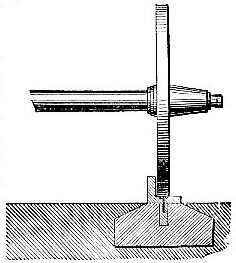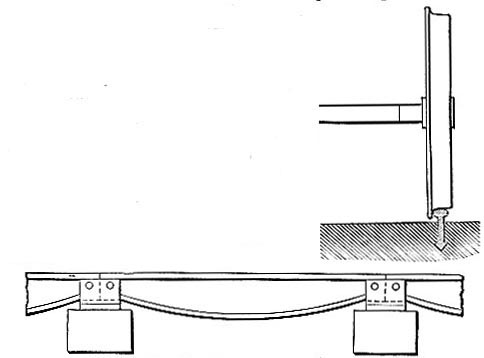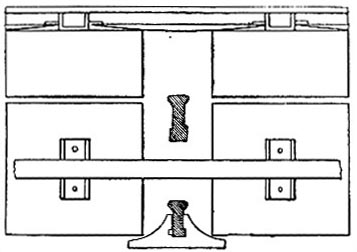1902 Encyclopedia > Railway, Railways (Railroad) > Early Wooden Tramways. Iron Rails on Tram Roads.
Railway, Railways
(Part 1)
A. RAILWAYS - HISTORY
Early Wooden Tramways. Iron Rails on Tram Roads.
Railways had their origin in the tramways which were laid more than two hundred years ago in the mineral districts of England for the conveyance of coal to the sea. In those days, before Macadam, roads bearing heavy traffic were with difficulty kept in repair. This led to the plan of laying planks or timbers at the bottom of the ruts as a better contrivance than filling in with stones, and then to laying rails of timber on the level surface. In 1676 tramways consisted of rails of timber laid "from the colliery to the river exactly straight and parallel, and bulky carts were made with four rollers fitting the rails, whereby the carriage was so easy that one horse would draw down four or five chaldron of coals." The rails originally were formed of scantlings of good sound oak, and were connected by sills or cross timbers of the same material pinned together with oak trenails. By and by an additional or wearing rail, which could be easily renewed when worn, was placed above the supporting rail, and it was then possible to cover the cross pieces or sleepers with earth to protect them from the horses’ feet. These ways, laid by permission of local proprietors, were called "way-leaves." It became a common practice to nail down bars of wrought iron on the surface of the ascending inclines of the road. These bars or rails were about 2 inches wide and half an inch thick, and were fastened to the wood rails by counter-sunk spikes. But the iron bars, not being stiff enough, were considerably bent when the trucks were loaded, and the resistance was reduced but slightly below that of a well-constructed double wooden tramway. (Footnote 223-2) Nevertheless, while the regular load of coals for one horse on the common road was but 17 cwt., on the tramway the horse could regularly take a load of 42 cwt.

Fig. 1. The tram road, 1776-1800.
Cast-iron was first tried incidentally as a material for rails in 1767 by the Coal-brookdale Iron Company. The iron rails were cast in lengths of 5 feet, 4 inches wide, and 1 1/4 inches thick, formed with three holes, through which they were fastened to the oak rails. The tramway was developed into the railway by the employment of cast-iron flange rails (fig. 1) to replace the wooden rails; the continuous flange or ledge on their inner edge kept the wheels on the track. The roads were then called tram-roads, provably as an abbreviation of trammel-roads, the flanges of the rails being in reality trammels to gauge the road and confine the wheels to the track.

Fig. 2. The edge rail, 1789.
The leading objection to this system was that the rail was liable to be covered with dust. Jessop therefore in 1789 laid down at Loughborough cast-iron "edge rails," raised above the ground so as to allow a flanged cast-iron wheel to run on them (fig. 2). This appears to have been the first system of rails laid on cast-iron chairs and on sleepers. The rails were pinned or bolted into the chairs.

Fig. 3. The fish-belly rail, 1820-30.
A wrought-iron rail was patented by Birkenshaw in 1820, as the "fish-belly" rail, similar in form and mode of support to Jessop’s rail, but rolled in continuous lengths, embracing a number of spans, with stiffening ledges of flanges on the under side. This form of rail grew into favour. It weighed 33 lb. per yard, and was laid in cast-iron chairs, spiked down to square or stone blocks at 3-feet bearings (see fig. 3). The edge rail and the flanged wheel constitute the basis of the whole system of a railway. The rails forming a line of way were placed to a gauge or distance apart of 4 feet 8 1/2 inches, and two parallel lines of way were spaced with 6 feet between the inner rails of the ways. This interspace is popularly known as the "six-foot."
Footnote
223-2 The earliest system of way on the Baltimore and Ohio Rairoad, and other railroads in the United States was a simple construction of this compound of wood and iron. As the ends of the bars became loose and turned upwards they were known as "snakes' heads." Occasionally they pierced the floors of the carriages and injured passengers.
Read the rest of this article:
Railway, Railways - Table of Contents
|


